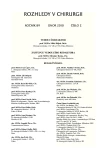Complications in Patients Undergoing Pulmonary Oncological Surgery
Authors:
L. Mitáš; T. Horváth; M. Sobotka; B. Garajová; I. Hanke; Z. Kala; I. Penka; J. Ivičič; J. Vomela
Authors‘ workplace:
Chirurgická klinika FN Brno a LF MU, přednosta: prof. MUDr. Zdeněk Kala, CSc.
Published in:
Rozhl. Chir., 2010, roč. 89, č. 2, s. 113-117.
Category:
Monothematic special - Original
Overview
Aim:
A survey evaluating incidence and risk factors of complications in persons underwent complete open lung resection because of primary or secondary lung malignancy.
Material and methods:
Retrospective study of 189 open surgery procedures in 128 males and 61 females, mean age males 61 years (range 21–78), females 64 years (range 33–80) during a five-years period (2003–2007). Data processing and analysis were performed with the statistical software system Statistica and compared by parametres odds ratio a χ2 test.
Results:
Complications were divided into five groups. First group was defined as complications in perioperative period and was composed of three events 1.5%: endotracheal tube dysfunction (i.e. 0.5%), heavy cardiac arrhytmia 0.5% and serious haemorrhage, that occurred immediately after operation 0.5%. Second group includes complications within period of 7 days after surgery: prolonged air leak (PAL > 7 days) 7.4%, bronchopneumonia 6.9%, cardiac arrhythmia 6.9%, postoperative delirium 4.2%, atelectasis 2.6%, wound infection 1.1%, bleeding 1.1% and chylothorax 0.5%. Third group contains events between 8th and 30th postoperative days: thoracic empyema 2.1%, dysphonia 2.1%, painfull shoulder 1.1 %, alimentary tract infection 0.5% and bronchial closure insufficiency 0.5 %. Fourth group contains patients with severe complications, that led to death during 30 days after operation: ischemic stroke 0.5% and pulmonary embolism 0.5%. Patients without any complication formed the fifth group of 60.5%.
Conclusion:
Main risk factors for complications in postoperative period after lung resection due to primary or secondary lung malignancy in our group of patients are COPD, corticotherapy, time of operation over 3 hours, BMI over 25, left side tumor localization and bronchoplastic procedure. For cardiac arrhytmia seems to be risk factor pneumonectomy and previous neoadjuvant radiochemotherapy.
Key words:
surgery complications – lung cancer surgery – lung cancer
Sources
1. Stolz, A., Schützner, J., Simonek, J., Lischke, R., Pafko, P.: Comparison of postoperative complications of 60- and 70-year-old patients after lung surgery. Interactive Cardiovascular and Thoracic Surgery, 2003; 2: 620–623.
2. Wada, H., Nakamura, T., Nakomoto, K., Maeda, M., Watanabe, Y. Thirty-day operative mortality for thoracotomy in lung cancer. J. Thorac. Cardiovasc. Surg., 1998; 115: 70–73.
3. Ferguson, M. K. Assessment of operative risk for pneumonectomy. Chest Surg. Clin. N. Am., 1999; 9: 339–351.
4. Patel, R. L., Townsend, E. R., Fountain, S. W. Elective pneumonectomy: factors associated with morbidity and operative mortality. Ann. Thorac. Surg., 1992; 54: 84–88.
5. Stephan, F., Boucheseiche, S., Hollande, J., et. al. Pulmonary complications following lung resection: a comprehensive analysis of incidence and possible risk factors. Chest, 2000; 118: 1263–1270.
6. Demmy, T. L., Curtis, J. J. Minimally invasive lobectomy directed toward frail and high-risk patients: a case-control study. Ann. Thorac. Surg., 1999; 68: 194–200.
7. Hoksch, B., Ablassmaier, B., Walter, M., Müller, J. M. Complication rate after thoracoscopic and conventional lobectomy. Zentralbl. Chir., 2003; 128: 106–110.
8. Park, B. J., Flores, R. M., Rush, V. W. Robotic assistance for video-assisted thoracic surgical lobectomy: Technique and initial results. J. Thorac. Cardiovasc. Surg., 2006; 131: 54–59.
9. Bernard, A., Ferrand, L., Hagry, O., Benoit, L., Cheynel, N., Favre, J. P. Identification of prognostic factors determining risk groups for lung resection. Ann. Thorac. Surg., 2000; 70: 1161–1167.
10. Strand, T. E., Rostad, H., Damhuis, R. A. M., Norstein, J. Risk factors for 30-day mortality after resection of lung cancer and prediction of their magnitude. Thorax., 2007; 62: 991–997.
11. Duque, J. L., Ramos, G., Castrodeza, J., Cerezal, J., Castanedo, M., Yuste, M. G., Heras, F. Early Complications in Surgical Treatment of Lung Cancer: A Prospective, Multicenter Study. Ann. Thorac. Surg., 1997; 63: 944–950.
12. Alexiou, Ch., Beggs, D., Rogers, M. L., Beggs, L., Asopa, S., Salama, F. D. Pneumonectomy for non-small cell lung cancer: predictors of operative mortality and survival. Eur. J. Cardiothorac. Surg., 2001; 20: 476–480.
13. Licker, M., Spiliopoulos, A., Frey, J. G., Robert, J., Höhn, L., Perrot, M., Tschopp, J. M. Risk Factors for Early Mortality and Major Complications Following Pneumonectomy for Non-small Cell Carcinoma of the Lung. Chest, 2002; 121: 1890–1897.
14. Brunelli, A., Monteverde, M., Borri, A., Salati, M., Marasco, R.D., Fianchini, A. Predictors of prolonged air leak after pulmonary lobectomy. Ann. Thorac. Surg., 2004; 77: 1205–1210.
15. Schussler, O., Alifano, M., Dermine, H., Strano, S., Casetta, A., Sepulveda, S., Chafik, A., Coignard, S., Rabbat, A. and Regnard, J. F. Postoperative Pneumonia after Major Lung Resection. Am. J. Respir. and Crit. Care Med., 2006; 173: 1161–1169.
16. Suemitsu, R., Sakoguchi, T., Morikawa, K., Yamaguchi, M., Tanaka, H., Takeo, S. Effect of Body Mass Index on Perioperative Complications in Thoracic Surgery. Asian Cardiovasc. Thorac. Ann., 2008; 16: 463–467.
17. Smith, P. W., Wang, H.,Gazoni, L. M., Shen, K. R., Daniel, T. M., Jones, D. R. Obesity does not increase complications after anatomic resection for non-small cell lung cancer. Ann. Thorac. Surg., 2007; 84: 1098–1105; discussion 1105–1106.
18. Aoki, T., Yamato, Y., Tsuchida, M., Watanabe, T., Hayashi, J., Hirono, T. Pulmonary complications after surgical treatment of lung cancer in octogenarians. Eur. J. Cardiothorac. Surg., 2000; 18: 662–665.
Labels
Surgery Orthopaedics Trauma surgeryArticle was published in
Perspectives in Surgery

2010 Issue 2
Most read in this issue
- Osteoplastic Decompressive Craniotomy – Indication and Surgical Technique
- Complications in Patients Undergoing Pulmonary Oncological Surgery
- PCCP – First Choice of the Treatment of Trochanteric Fractures in our Orthopaedic Department
- Type II Bile Duct Cyst or Accessory Gall Bladder?
